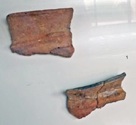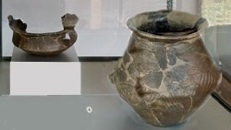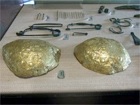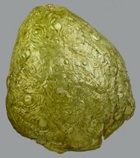Finds from San Marco, Gubbio

A neolithic settlement has been excavated at San Marco, outside Gubbio (visited in Walk II). Its economy was based essentially on agriculture and on the rearing of animals. The exhibits in showcase 1 include vessels used domestically and stone tools used in agriculture.
Finds from Grotta Bella


The cave known as Grotta Bella is on Monte Aiola near Avigliano Umbro (roughly half way between Amelia and Todi). It was discovered in 1902 and excavated by the Soprintendenza per i Beni Archeologici dell'Umbria in 1970-2. It was inhabited from neolithic times (5000-3000 BC) until the late Bronze Age (1200-1000 BC). Finds from the site exhibited here (in showcases 4 and 5) are from the late Bronze Age and include this ancient bronze dagger.
Votive objects found during the excavations provide evidence for the cult use of the site from the 7th until the 1st century BC. The prevalence of votive offerings and coins from the 3rd century BC suggest that this was the period of greatest cult use. The site was probably abandoned after the Social Wars (90-89 BC). There is an interesting photographic exhibition relating to this site in the Museo Archeologico, Amelia.
Finds from Via Settevalli, Perugia


A late Bronze Age settlement in Via Settevalli was excavated in 1988-9 in what was then an area of suburban marshland. The finds exhibited in showcase 8 include:
-
✴a flint arrow head; and
-
✴ancient impasto (clay) fragments.
Finds from Colle del Capitano, near Spoleto
In 1902, a farmer called Isidoro Vannozzi discovered a grave under a field of his farm on Colle del Capitano, outside Monteleone di Spoleto. It contained rich grave goods that included a celebrated ceremonial chariot that is now in the Metropolitan Museum, New York.
Subsequent excavations of the area have revealed an extensive necropolis that probably belonged to a community that was dispersed along the Nera Valley and that used a series of hill forts in the region, the most important of which was on Colle del Capitano. From this work, it became clear that the necropolis had in fact been in use mainly for cremations since the 12th century BC, with a period of interruption in the 7th century followed by the emergence of mainly inhumation tombs on the site in the 6th century.
These excavations occurred in two phases:
-
✴44 tombs (12th - 6th centuries BC) were found during excavations in 1907, and the associated grave goods were sent to the Museo Archeologico, Florence.
-
✴An opportunity for further excavation arose in the late 1970s when some of the farm buildings were demolished. A further 26 tombs (20 cremation tombs and 6 inhumation tombs) came to light during this and subsequent campaigns.
-
•Grave goods from this phase are mainly in the in the Museo Archeologico, Spoleto.
-
•Other grave goods here (in showcase 10) include these late Bronze Age impasto (clay) cinerary urns from tombs 14 and 15.

Necropolis in Via dei Consoli, Gubbio

A late Bronze Age necropolis was discovered during roadwork on Via dei Consoli in 2007 (see Walk I). It probably served the ancient settlements that have been discovered in the surrounding uplands and on their lower slopes, near Sant’ Agostino and Palazzo Vescovile. The area of excavation was necessarily limited, and it seems likely that other graves survive nearby.
The excavations uncovered some 40 impasto (clay) lidded cinerary urns, one of which (from Tomb 17) is exhibited here (showcase 10). Other finds from this necropolis are exhibited in the Antiquarium, Gubbio.
Valle di San Marzio, Gualdo Tadino (ca. 12th century BC)
Showcase 12 contains a hoard of ancient objects that was discovered outside Gualdo Tadino in the early 1930s. In an article of 2012 in “Il Nuovo Serrasanta” (page 4), Augusto Bossi recalled how he made the discovery as a young boy of 7 0r 8, while playing by the path near his home that led from the Valle di Santo Marzio to the Fonti della Rocchetta (see Excursions from Gualdo Tadino). His father kept the objects for a while before showing them to a local historian, Ruggero Guerrieri, who promptly bought them. They fortunately found their way to the archeological collection of Perugia ( by what means, Signor Bossi did not know, but most probably donated by Ruggero Guerrieri).


Finds from Belverde
Showcases 13-16 contain a collection of objects from the excavations of an early bronze age settlement at Belverde on Monte Cetona (40 km from Perugia, towards Chiusi) that Umberto Calzoni carried out in 1927-41.
Turn right at the end of the corridor to see the artefacts
in the room that I have designated Roman Umbria I.
Return to the main page on the Museo Archeologico.



